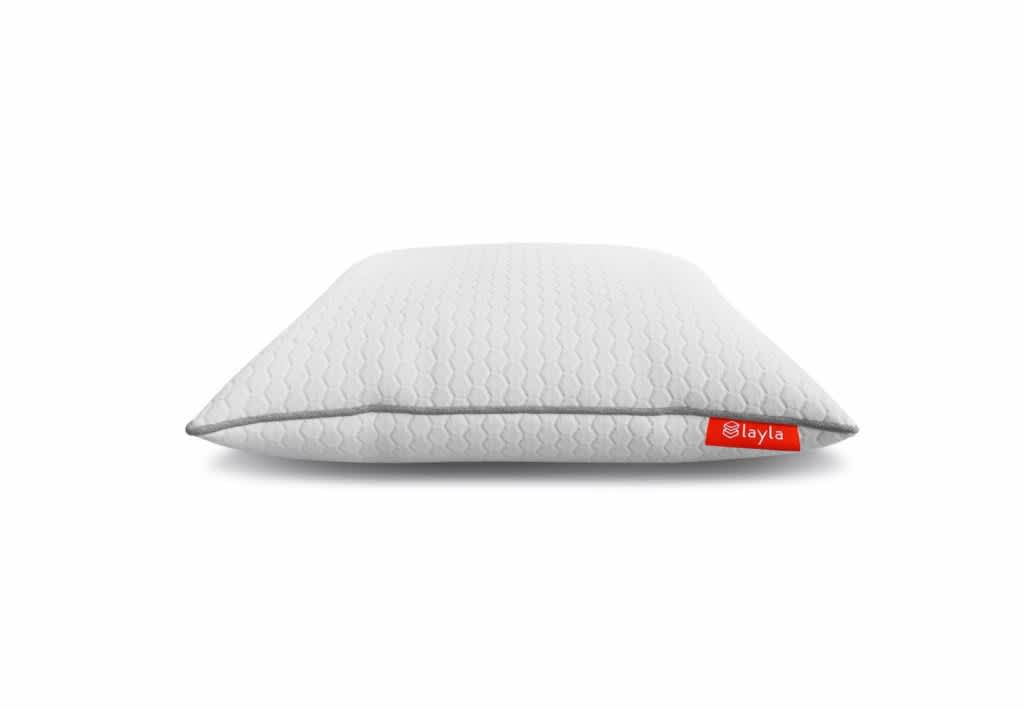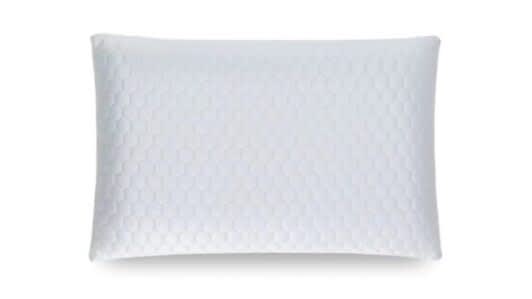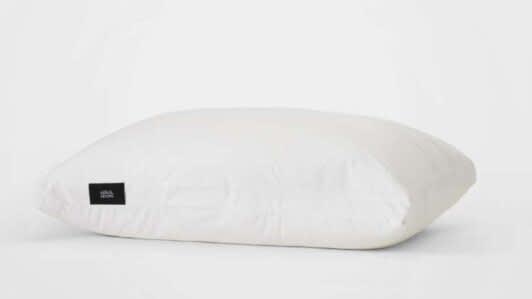On This Page
Best Memory Foam Pillow
Our Team’s Top Picks for Adaptive Comfort
Our Top Picks
-
Best Overall Pillow
Sleep Is the Foundation Shredded Memory Foam Pillow -
Best Value Pillow
Marlow Pillow -
Most Comfortable Pillow
Layla Memory Foam Pillow -
Best Cooling Pillow
Brooklyn Bedding Luxury Cooling Memory Foam Pillow -
Best Pillow for Neck Pain
Silk & Snow Pillow
Best Overall Pillow
Highlights
Highlights
- Shredded memory foam is moldable and offers close contouring
- Loft and firmness are adjustable
- Removable and machine-washable cover
Ideal For
- Side and back sleepers
- Shoppers who aren’t sure of their ideal pillow loft
- Sleepers who enjoy squishing and molding their pillow
Full Details
Best Value Pillow
Highlights
Highlights
- Adjustable loft and firmness
- Shredded memory foam and polyester filling
- 365-day return period
Ideal For
- Shoppers on a budget
- Combination sleepers
- People who want to try different lofts
Full Details
Most Comfortable Pillow
Highlights
Highlights
- Adjustable loft and firmness with extra filling available for purchase
- Shredded open-cell memory foam and polyester filling
- Lined with gel-infused memory foam
Ideal For
- People in need of extra support without extra loft
- Back, side, and stomach sleepers
- Sleepers who enjoy the feel of a traditional pillow
Full Details
Best Cooling Pillow
Highlights
Highlights
- Available in low- and high-profile lofts
- Single-piece design made with open-cell memory foam
- Copper and graphite infusions designed to prevent heat retention
Ideal For
- Very warm sleepers
- Those looking for a closely conforming pillow
- People with allergies
Full Details
Best Pillow for Neck Pain
Highlights
Highlights
- Adjustable loft with a medium feel
- Shredded memory foam core
- Down alternative outer chamber for an extra-soft surface
Ideal For
- People who enjoy sinking into their pillow but need neck support
- Most side, back, and stomach sleepers
- Sleepers with chronic shoulder tension
Full Details
How We Test Pillows
We test pillows against the same set of strict standards that we use for other pillow types, but we pay close attention to several factors that set different pillows apart. In addition to firmness, conforming, and ease of cleaning, we also measure breathability. Many sleepers choose specific materials for their cool feel. To determine how well a pillow regulates temperature, we use thermal sensors that measure heat retention and we try them ourselves too, taking notes on how warm or cool we think a pillow feels after use.
What Types of Memory Foam Pillows Are There?
Memory foam pillows are made with either a single piece of foam or a case filled with shredded foam, and each type is available in various shapes and designs. Memory foam itself is made from treated polyurethane foam. The treatment process results in a foam that molds closely to your body to reduce pressure and tension. Once you get up, the memory foam regains its original shape.
While solid memory foam pillows are made from memory foam alone, some shredded foam pillows may contain a mix of memory foam and ordinary polyfoam, or a mix of memory foam and a down alternative.
Solid memory foam pillows tend to be more supportive and are sometimes shaped to provide targeted support to your neck and spine. They may have removable inserts, but they generally aren’t very adjustable. Shredded memory foam pillows, on the other hand, are usually less supportive, but their shape can easily be adjusted to suit your needs.
Because memory foam pillows can sometimes sleep hot, solid pillows may have tiny holes drilled through them. Pillows that use shredded memory foam have a bit of an advantage, since they already have good airflow around the irregular foam pieces that make up their fill. Additional features, like foam or fabric with cooling properties, can also help a pillow stay at a comfortable temperature.
In terms of firmness, most memory foam pillows are medium soft or medium. However, many shredded memory foam pillows have adjustable firmnesses based on how much foam you add or remove.
- One-piece (solid foam) pillows: Solid memory foam pillows are available in a traditional pillow style or shaped to give your neck and shoulders better support. People with neck or back pain may prefer this style. These pillows also tend to have higher lofts than shredded foam pillows, making them better for side and back sleepers.
- Shredded foam pillows: Shredded foam pillows are usually shaped like a traditional pillow. They also feel more like a traditional pillow since they allow your head to sink more deeply. However, this style also provides less targeted support. Shredded foam pillows often make a good choice for side, stomach, and combination sleepers.
Memory foam pillows are a great option if you want pressure relief without having to sacrifice support. Memory foam retains its shape really well, so once you take your head off the pillow, it takes its original form without needing to be fluffed.
Sizing Options for Memory Foam Pillows
Memory foam pillows are usually available in standard, queen, and king sizes. Standard size pillows are appropriate for most people, but larger pillows allow you to use the full width of a queen or king size mattress. Unique pillow shapes and sizes, such as memory foam wedge pillows or body pillows, are also available.
The height, or loft, of a pillow tends to vary depending on design. The width and length of a pillow may also differ depending on the manufacturer, but most follow the standard dimensions.
Memory Foam Pillow Sizes
| Pillow Size | Dimensions |
|
Standard |
20” x 26” |
|
Queen |
20” x 30” |
|
King |
20” x 36” |
Will a Memory Foam Pillow Work for You?
Whether a memory foam pillow is suitable for you depends on your personal preferences as well as your preferred sleeping position, budget, and need for support.
Memory foam pillows are usually more supportive than traditional down or down alternative pillows. They also tend to avoid causing neck strain, which can be a problem with traditional pillows, which have a lower loft.
Down pillows tend to have a longer lifespan than memory foam pillows, but down alternative pillows have a shorter lifespan.
Memory foam designs are among the most popular nontraditional pillows. However, pillows made of other materials are also available.
Latex pillows are similar in design and price to many memory foam pillows, but they are made of natural rubber foam rather than synthetic polyfoam. These pillows generally sleep cooler than memory foam but conform less around the neck and shoulders. Latex pillows may be made with shredded fill or a single piece of latex.
Pillows made of buckwheat or synthetic beads can offer as much pressure relief as memory foam pillows. However, they tend to feel different than a traditional pillow, making them less appealing to some sleepers. Additionally, while they sleep cooler than memory foam, buckwheat and bead pillows can be noisy compared to memory foam pillows, which are completely silent.
Pros and Cons of Memory Foam Pillows
How Much Do Memory Foam Pillows Cost?
Most memory foam pillows cost between $50 and $150. Pillows that cost less than this range may be thin and lack durability, while those above this range often include luxury features.
Memory foam pillows often cost more than polyester or down alternative pillows. However, they tend to have a lower price-point than down pillows. Other types of pillows, such as latex or buckwheat, can vary widely in cost.
Are Memory Foam Pillows Good for Side Sleepers?
Memory foam pillows are an ideal choice for many side sleepers. The wrong pillow loft can cause tension on both sides of the neck and shoulders, but memory foam adapts to pressure to form a spine-supporting cradle.
While the surface of memory foam pillows may feel plush and comfortable, the core remains firm. This is a critical feature for side sleepers, as a pillow that’s too soft will lack the support side sleepers need.
What About Back or Stomach Sleepers?
Back sleepers require a pillow that supports the neck while cradling the back of the head. A pillow that’s too soft lacks the necessary support, while a pillow that’s too firm can cause neck strain. Single-piece memory foam pillows are supportive and contouring, making them a popular choice for back sleepers.
However, single-piece memory foam pillows are rarely suitable for stomach sleepers, who usually prefer a softer, flatter pillow. Some adjustable shredded foam pillows may work for stomach sleepers, but removing too much filling can cause these pillows to feel unsupportive. Other types of pillows, such as down or down alternative pillows, may be more appropriate.
Matching a Memory Foam Pillow to Your Needs
As with mattresses, the most critical step in choosing a pillow is to match your preferred sleep position and body shape. While deciding between a shredded foam or single-piece memory foam pillow is the first step, it’s also important to consider different designs within those categories.
Pillow Height (or Loft)
A pillow’s height is also called its loft. If a pillow’s loft is too high or too low, it can cause muscle tension and prevent your spine from resting in a neutral position.
Single-piece memory foam pillows usually have a single loft height, while the loft of shredded foam pillows can be adjustable.
How Firm Should Your Pillow Be?
The ideal firmness for a memory foam pillow depends on your preferred sleep position. The appropriate firmness usually corresponds to the appropriate loft, with both factors working together to keep your neck in the correct place for good spinal alignment.
The surface of a single-piece memory foam pillow softens and conforms to your body without compromising the core’s firmness. Shredded foam pillows behave more like down pillows, though adjustable varieties may allow you to add or remove stuffing for a firmer or softer feel.
Support and Keeping Your Spine Aligned
Support is key when discussing mattresses and pillows. When you are properly supported by your bed, your spine relaxes into a natural, neutral position, which prevents pressure buildup and tension.
Pillows usually have the greatest impact on spinal alignment in your upper back and neck. Sleeping on a pillow with the wrong loft, for example, keeps your neck at an awkward angle all night. This can cause next-day stiffness or soreness and contribute to chronic muscle tension.
You can get memory foam pillows in pretty much any shape you can possibly think of. With that many choices, it’s important to think about the basics – getting a loft and firmness level combo that works well for your weight and sleeping position.
Caring for Your Memory Foam Pillow
Memory foam pillows are not difficult to care for, but they do have different care requirements than other types of pillows. By cleaning your pillow regularly according to the manufacturer’s instructions, you’ll have a better chance of enjoying it for its entire expected lifespan.
Pillow Cleaning and Care
All memory foam pillows should be cared for according to the manufacturer’s guidelines. A cleaning routine that works for one pillow may not work for another pillow, even if they appear to be similar.
Most single-piece memory foam pillows can only be spot-cleaned. Some shredded foam pillows are machine-washable, but most require you to take the filling out before washing. Although waterproof pillow covers can prevent stains, this protection comes at the expense of airflow and may leave your pillow feeling very warm.
How to Handle Off-Gassing From Your New Pillow
New memory foam pillows sometimes have a new pillow smell, which is caused by volatile organic compounds, or VOCs. While generally considered harmless, VOCs can have an unpleasant chemical scent when they’re first unwrapped. Those sensitive to strong smells may want to leave their new pillow a well-ventilated place with good airflow until the odor is gone. Sunlight can also help, though prolonged exposure may damage the memory foam.
Boost Your Pillow’s Lifespan
Dirt, stains, dust, and oil from your skin can all cause a memory foam pillow to break down faster than it would otherwise. However, there are some steps you can take to help your pillow last longer.
- Always use a pillowcase
- Use a pillow protector if necessary
- Wash the pillow casings regularly
- Spot-clean or wash the pillow as recommended by the manufacturer
- If the pillow gets wet, make sure to dry it completely before using it again
- Regularly fluff shredded foam pillows
- Don’t leave heavy objects on the pillow
Explore More Pillows
If you’re looking for a particular type of pillow, check out our other guides below.





